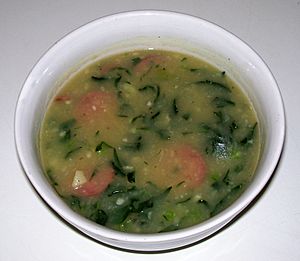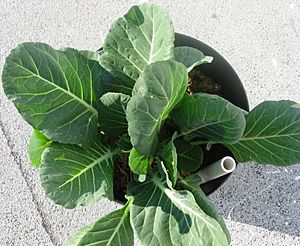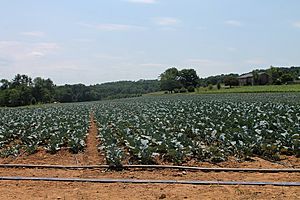Collard greens facts for kids
Collard greens, often just called collards, are a type of plant grown for their big, dark green leaves that people love to eat. They are related to other leafy greens like kale. Collards are part of the Brassica oleracea family, which also includes cabbage and broccoli.
These plants have large, tasty leaves and can even be grown just for their beauty in a garden. You can find collard greens all year long. However, they often taste even better and have more nutrients when it's colder, especially after the first frost of the year.
Contents
What Are Collard Greens?
The "Headless" Plant
The name for this group of plants is "Acephala." This is a Greek word that means "without a head." It describes collard greens well because, unlike cabbage, they don't form a tight, round "head" of leaves. Instead, their leaves grow loosely around a central stem.
How Collards Grow
Collard plants can grow quite tall, sometimes up to two feet high. They have a strong, upright stem. In places where winter gets cold, collards grow for two years (they are a biennial plant). In warmer areas, they can grow for many years (they are a perennial plant). Collards are a lot like kale in how they look and grow.
Some popular types of collard greens include 'Georgia Southern', 'Morris Heading', and 'Butter Collard'.
Growing and Storing Collards
Farmers grow collard greens for their thick, edible leaves. These leaves have a slightly bitter taste that many people enjoy. As mentioned, collards are available all year. They taste best and are most nutritious during the colder months, especially after the first frost.
Picking and Storing Leaves
For the best eating experience, collard leaves are often picked before they grow to their biggest size. Younger leaves tend to have a better texture. The age of the leaf doesn't change its flavor much. The type of collard plant (its cultivar) can also affect how it tastes and feels when you eat it.
Fresh collard leaves can stay good in the refrigerator for about three days. If you cook them, you can freeze them to keep them fresh for much longer.
Why Collards Are Good For You
Collard greens are packed with good things for your body! Just like kale, they have a lot of vitamin K. This vitamin is super important for helping your blood clot and keeping your bones strong.
Collards are also a great source of vitamin A, vitamin C, and manganese. They also give you a good amount of calcium and vitamin B6. A small serving of cooked collard greens has very few calories and is mostly water. It also contains protein, carbohydrates, and a tiny bit of fat.
How People Eat Collard Greens
People have been eating collard greens for a very long time, over 2000 years! Even the ancient Greeks grew different kinds of collards and kale. Today, collards are enjoyed in many parts of the world.
Collards in the Southern United States
In the Southern U.S., collard greens are a very popular vegetable. They are often cooked with other leafy greens like turnip greens or spinach to make a dish called "mixed greens".
When cooking collards, people often add smoked meat like ham hocks or smoked turkey. They also use onions, vinegar, salt, and pepper. Some cooks even add a little sugar. A tradition in the South is to eat collards on New Year's Day. This is often done with black-eyed peas and cornbread. The cornbread is perfect for soaking up the "pot liquor"—the tasty, nutrient-rich broth left after cooking the collards.
Collards in East Africa
In countries like Tanzania and Kenya, collard greens are known as sukuma wiki. This name means "to push the week" or "to stretch the week," because they are an affordable and common food. Sukuma wiki is usually lightly cooked in oil with onions and salt. It's served as a main side dish with meat like fish, chicken, or beef. Thinly sliced collard greens are also a key part of a popular dish called ugali, which is a type of maize flour cake.
Collards in Brazil and Portugal

In Portugal and Brazil, collard greens (called couve) are a common side dish for fish and meat. They are a standard part of feijoada, a famous stew made with pork and beans.
Thinly sliced collard greens are also a main ingredient in the popular Portuguese soup, caldo verde (which means "green broth"). For this soup, the leaves are cut into very thin strips and added to the other ingredients just before serving.
Collards in Kashmir
In the Kashmir Valley, collard greens (called haak) are eaten with almost every meal. People eat both the leaves and the roots. Young, tender leaves are picked in early spring. Later, mature plants are pulled up with their roots. Older leaves are also harvested from growing plants.
The roots and leaves can be cooked together or separately. A common dish is haak rus, which is a soup of whole collard leaves cooked with water, salt, oil, and spices. It's usually eaten with rice. Collard leaves are also cooked with meat, fish, or cheese. In winter, collard leaves and roots are fermented to make a popular pickle called haak-e-aanchaar.
Images for kids
See also
 In Spanish: Berza o col forrajera para niños
In Spanish: Berza o col forrajera para niños




